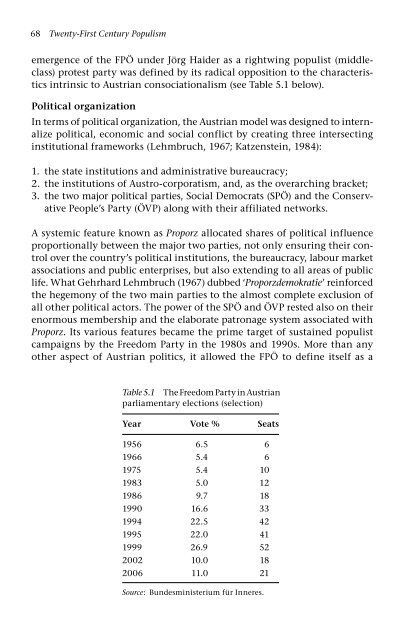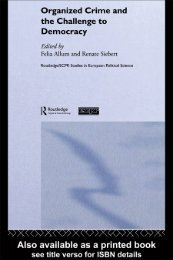- Page 1 and 2:
Twenty-First Century Populism The S
- Page 3 and 4:
This page intentionally left blank
- Page 5 and 6:
Editorial matter, selection, introd
- Page 7 and 8:
This page intentionally left blank
- Page 9 and 10:
viii Contents 12 Britain: Imperial
- Page 11 and 12:
Acknowledgements The original conce
- Page 13 and 14:
xii Notes on Contributors Bollati B
- Page 15 and 16:
2 Twenty-First Century Populism pro
- Page 17 and 18:
4 Twenty-First Century Populism rig
- Page 19 and 20:
6 Twenty-First Century Populism bet
- Page 21 and 22:
8 Twenty-First Century Populism be
- Page 23 and 24:
10 Twenty-First Century Populism or
- Page 25 and 26:
This page intentionally left blank
- Page 27 and 28:
This page intentionally left blank
- Page 29 and 30: 16 Twenty-First Century Populism bu
- Page 31 and 32: 18 Twenty-First Century Populism el
- Page 33 and 34: 20 Twenty-First Century Populism se
- Page 35 and 36: 22 Twenty-First Century Populism an
- Page 37 and 38: 24 Twenty-First Century Populism wo
- Page 39 and 40: 26 Twenty-First Century Populism Am
- Page 41 and 42: 28 Twenty-First Century Populism Co
- Page 43 and 44: 3 Politics against Democracy: Party
- Page 45 and 46: 32 Twenty-First Century Populism su
- Page 47 and 48: 34 Twenty-First Century Populism We
- Page 49 and 50: 36 Twenty-First Century Populism it
- Page 51 and 52: 38 Twenty-First Century Populism Wh
- Page 53 and 54: 40 Twenty-First Century Populism th
- Page 55 and 56: 42 Twenty-First Century Populism Am
- Page 57 and 58: 44 Twenty-First Century Populism ov
- Page 59 and 60: 46 Twenty-First Century Populism th
- Page 61 and 62: 48 Twenty-First Century Populism th
- Page 63 and 64: 50 Twenty-First Century Populism th
- Page 65 and 66: 52 Twenty-First Century Populism A
- Page 67 and 68: 54 Twenty-First Century Populism po
- Page 69 and 70: 56 Twenty-First Century Populism 3.
- Page 71 and 72: 58 Twenty-First Century Populism pr
- Page 73 and 74: 60 Twenty-First Century Populism In
- Page 75 and 76: 62 Twenty-First Century Populism th
- Page 77 and 78: 64 Twenty-First Century Populism it
- Page 79: This page intentionally left blank
- Page 83 and 84: 70 Twenty-First Century Populism As
- Page 85 and 86: 72 Twenty-First Century Populism Ge
- Page 87 and 88: 74 Twenty-First Century Populism co
- Page 89 and 90: 76 Twenty-First Century Populism un
- Page 91 and 92: 78 Twenty-First Century Populism br
- Page 93 and 94: 80 Twenty-First Century Populism In
- Page 95 and 96: 82 Twenty-First Century Populism ob
- Page 97 and 98: 6 Italy: A Country of Many Populism
- Page 99 and 100: 86 Twenty-First Century Populism ha
- Page 101 and 102: 88 Twenty-First Century Populism an
- Page 103 and 104: 90 Twenty-First Century Populism of
- Page 105 and 106: 92 Twenty-First Century Populism pe
- Page 107 and 108: 94 Twenty-First Century Populism Th
- Page 109 and 110: 96 Twenty-First Century Populism Re
- Page 111 and 112: 98 Twenty-First Century Populism In
- Page 113 and 114: 7 Switzerland: Yet Another Populist
- Page 115 and 116: 102 Twenty-First Century Populism s
- Page 117 and 118: 104 Twenty-First Century Populism T
- Page 119 and 120: 106 Twenty-First Century Populism S
- Page 121 and 122: 108 Twenty-First Century Populism r
- Page 123 and 124: 110 Twenty-First Century Populism h
- Page 125 and 126: 112 Twenty-First Century Populism a
- Page 127 and 128: 114 Twenty-First Century Populism t
- Page 129 and 130: 116 Twenty-First Century Populism o
- Page 131 and 132:
118 Twenty-First Century Populism d
- Page 133 and 134:
120 Twenty-First Century Populism i
- Page 135 and 136:
122 Twenty-First Century Populism i
- Page 137 and 138:
124 Twenty-First Century Populism F
- Page 139 and 140:
126 Twenty-First Century Populism T
- Page 141 and 142:
128 Twenty-First Century Populism s
- Page 143 and 144:
130 Twenty-First Century Populism n
- Page 145 and 146:
132 Twenty-First Century Populism i
- Page 147 and 148:
134 Twenty-First Century Populism l
- Page 149 and 150:
136 Twenty-First Century Populism s
- Page 151 and 152:
138 Twenty-First Century Populism d
- Page 153 and 154:
140 Twenty-First Century Populism T
- Page 155 and 156:
142 Twenty-First Century Populism b
- Page 157 and 158:
144 Twenty-First Century Populism W
- Page 159 and 160:
146 Twenty-First Century Populism t
- Page 161 and 162:
148 Twenty-First Century Populism T
- Page 163 and 164:
150 Twenty-First Century Populism o
- Page 165 and 166:
152 Twenty-First Century Populism p
- Page 167 and 168:
154 Twenty-First Century Populism S
- Page 169 and 170:
156 Twenty-First Century Populism A
- Page 171 and 172:
158 Twenty-First Century Populism h
- Page 173 and 174:
160 Twenty-First Century Populism u
- Page 175 and 176:
162 Twenty-First Century Populism t
- Page 177 and 178:
164 Twenty-First Century Populism a
- Page 179 and 180:
11 France: The FRONT NATIONAL, Ethn
- Page 181 and 182:
168 Twenty-First Century Populism a
- Page 183 and 184:
170 Twenty-First Century Populism S
- Page 185 and 186:
172 Twenty-First Century Populism i
- Page 187 and 188:
174 Twenty-First Century Populism a
- Page 189 and 190:
176 Twenty-First Century Populism v
- Page 191 and 192:
178 Twenty-First Century Populism a
- Page 193 and 194:
180 Twenty-First Century Populism t
- Page 195 and 196:
182 Twenty-First Century Populism w
- Page 197 and 198:
184 Twenty-First Century Populism T
- Page 199 and 200:
186 Twenty-First Century Populism 9
- Page 201 and 202:
188 Twenty-First Century Populism i
- Page 203 and 204:
190 Twenty-First Century Populism L
- Page 205 and 206:
192 Twenty-First Century Populism f
- Page 207 and 208:
194 Twenty-First Century Populism e
- Page 209 and 210:
196 Twenty-First Century Populism t
- Page 211 and 212:
13 The Republic of Ireland: The Dog
- Page 213 and 214:
200 Twenty-First Century Populism f
- Page 215 and 216:
202 Twenty-First Century Populism t
- Page 217 and 218:
204 Twenty-First Century Populism A
- Page 219 and 220:
206 Twenty-First Century Populism l
- Page 221 and 222:
208 Twenty-First Century Populism m
- Page 223 and 224:
210 Twenty-First Century Populism d
- Page 225 and 226:
212 Twenty-First Century Populism c
- Page 227 and 228:
214 Twenty-First Century Populism c
- Page 229 and 230:
216 Twenty-First Century Populism f
- Page 231 and 232:
218 Twenty-First Century Populism i
- Page 233 and 234:
220 Twenty-First Century Populism P
- Page 235 and 236:
222 Twenty-First Century Populism e
- Page 237 and 238:
Bibliography Akkerman, T. Anti-immi
- Page 239 and 240:
226 Bibliography BNP (2005) Rebuild
- Page 241 and 242:
228 Bibliography Dahl, R. A. (1999)
- Page 243 and 244:
230 Bibliography Germani, G. (1975)
- Page 245 and 246:
232 Bibliography Ivaldi, G. Le Fron
- Page 247 and 248:
234 Bibliography Lehingue, P. (2003
- Page 249 and 250:
236 Bibliography Mazzoleni, G. (200
- Page 251 and 252:
238 Bibliography Pelinka, A. (2005)
- Page 253 and 254:
240 Bibliography Schedler, A. Anti-
- Page 255 and 256:
242 Bibliography Trechsel, A. H. (2
- Page 257 and 258:
This page intentionally left blank
- Page 259 and 260:
246 Index Chirac, Jacques 58, 168,
- Page 261 and 262:
248 Index Jagers, Jan 58 Jansson, M
- Page 263 and 264:
250 Index Plato 200 Poland 62, 120



